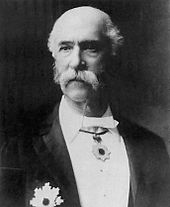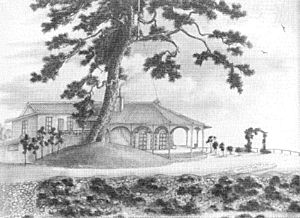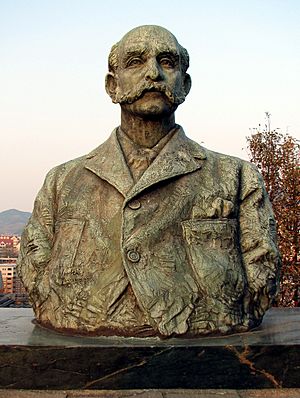Thomas Blake Glover facts for kids
Quick facts for kids
Thomas Blake Glover
|
|
|---|---|
 |
|
| Born | 6 June 1838 Fraserburgh, Aberdeenshire, Scotland
|
| Died | 16 December 1911 (aged 73) |
| Occupation | Businessman |
| Spouse(s) | Yamamura Tsuru |
Thomas Blake Glover was a Scottish businessman who lived a long time in Japan. He was born on June 6, 1838, and passed away on December 16, 1911. He played a big part in Japan's history during a time of great change.
Contents
Early Life and Moving to Japan
Thomas Blake Glover was born in Fraserburgh, Scotland, on June 6, 1838. He was one of eight children. His father, Thomas Berry Glover, worked as a coastguard officer, helping to protect the coast.
His family moved a few times because of his father's job. Young Thomas went to different schools. After school, he got a job as a shipping clerk for a big trading company called Jardine Matheson. In 1857, he moved to Shanghai, China.
Starting a Business in Japan
When he was 21, Thomas Glover moved from China to Nagasaki, Japan, in 1859. He started by buying Japanese green tea. Just two years later, he started his own company called Glover and Co.
His business was in Nagasaki. He built his home there, and it is still standing today. It is the oldest Western-style building in Japan.
Helping Japan Change
During Glover's time, Japan was going through big changes. Many Japanese people were unhappy with how their country was dealing with foreign powers. They wanted to bring back the Emperor as the main ruler and end the old government, called the Tokugawa shogunate.
Glover helped these groups by selling them weapons and warships. This was a risky business because it was against the rules set by other countries and Japan's own laws. But Glover believed in helping Japan modernize.
Supporting Future Leaders
In 1863, Glover helped five young Japanese students, known as the Chōshū Five, travel to London. They went to study Western technology and ideas. He also helped 15 students from another powerful group, Satsuma, travel abroad in 1865. These students later became important leaders in Japan's new government.
Glover also brought the first small locomotive (a train engine) and train cars to Japan in 1865. He showed them on a short track in Nagasaki. This helped Japan see how useful railways could be for transportation.
Building Ships and Mines
Because Glover helped the new government come to power, he had good connections with them. He helped order some of the first warships for the Imperial Japanese Navy. These ships were built in Scotland.
In 1868, Glover started developing Japan's first coal mine on Hashima Island. He also brought the first dry dock to Japan, which is a special area where ships can be repaired out of the water.
Thomas Glover faced financial difficulties in 1870. However, he stayed in Japan and continued to manage the Takashima coal mine for its owners. Later, a big Japanese company, Mitsubishi, took over the mine.
Founding Major Companies
Glover was very important in helping Japan become an industrial country. He helped start the shipbuilding company that later became the huge Mitsubishi Corporation of Japan. He also helped create the Japan Brewery Company, which later became the famous Kirin Brewery Company, Ltd., known for its beer. Some people even say the mustache on the Kirin beer label is a tribute to Glover's own mustache!
For all his work and contributions, Glover received a special award from the Japanese Emperor, called the Order of the Rising Sun.
Thomas Blake Glover passed away in Tokyo in 1911. He was buried in Nagasaki.
Glover's Family
Thomas Glover had a Japanese partner named Awajiya Tsuru. They lived together until Tsuru passed away in 1899. They had a daughter named Hana, born in 1876. Hana later married a British merchant and moved to Korea.
Thomas Glover also adopted a son, Kuraba Tomisaburō (born in 1870), who was part British and part Japanese. Tomisaburō grew up to make important contributions to Nagasaki's economy. He married a woman named Nakano Waka, who also had mixed British and Japanese heritage.
During World War II, Tomisaburō faced difficulties because of his mixed background. His wife Waka passed away in 1943, and Tomisaburō died in 1945, shortly after the atomic bombs were dropped on Japan.
Some people think that Glover's life might have inspired the famous opera Madama Butterfly. However, there isn't strong historical proof for this idea. It's more likely that after the war, American soldiers nicknamed Glover's old house the "Madame Butterfly House" because of its beautiful view, and local officials used this to attract tourists.
Glover's Homes
Glover's old home in Nagasaki is now a popular place for visitors called Glover Garden. Millions of people visit it every year. He also had a home in Tokyo.
The place where Glover was born in Scotland was damaged during World War II. Today, a special plaque marks the spot, and a museum nearby tells his story.
A house in Aberdeen, Scotland, called Braehead House (now Glover House), was bought by Glover's family in 1864. It later became a museum about Thomas Blake Glover's life.
Honors and Legacy
- He received the Order of the Rising Sun, a high honor from Japan, in 1908.
Because of his connections with the samurai groups and his interest in Japanese culture, Thomas Glover is sometimes called the "Scottish Samurai" in Scotland. There is even an award called the "Scottish Samurai" to honor people who build strong ties between Scotland and Japan.
In 2021, cherry blossom trees were planted in Scotland to remember Glover.
The Glover Whisky
A special series of whiskies, called "The Glover," was created in 2015. These whiskies celebrate Thomas Blake Glover's life and the long friendship between Scotland and Japan.
These whiskies are a mix of rare Japanese and Scottish single malt whiskies. They are known as the first Scottish-Japanese blend.
Glover in Stories
Thomas Glover is the main character in a novel called The Pure Land by Alan Spence. He is also the basis for a character named Jamie McFay in the book Gai-Jin by James Clavell. Glover also appears as a character in a Japanese video game called Ryū ga Gotoku Ishin!.
See also
 In Spanish: Thomas Blake Glover para niños
In Spanish: Thomas Blake Glover para niños
- Foreign cemeteries in Japan
- Anglo-Japanese relations
- Chōshū Five
- Richard Henry Brunton, another Scotsman who helped Japan in the 1800s
- Ernest Satow





